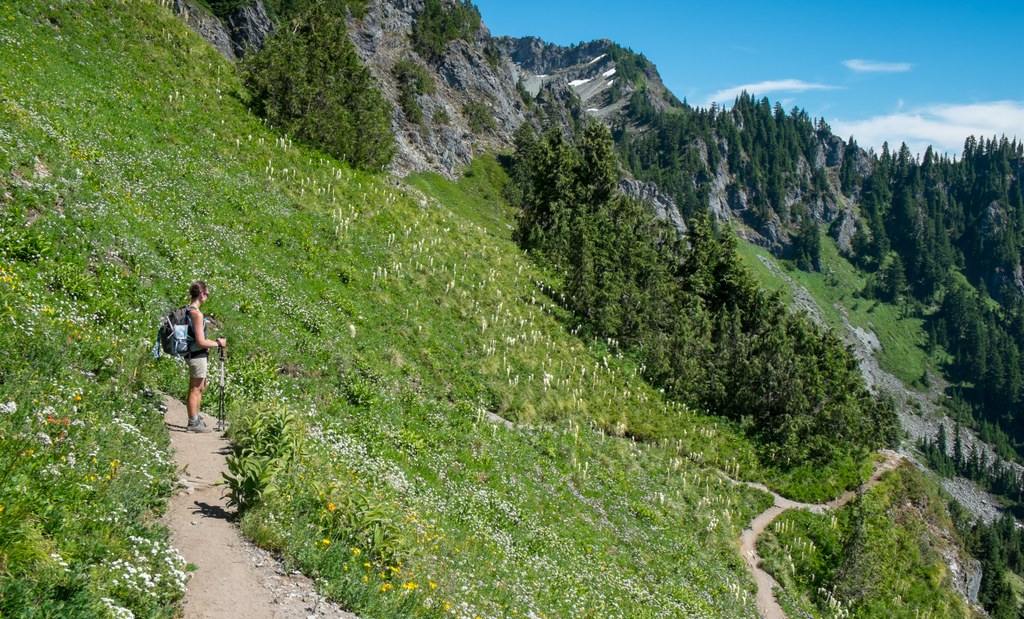This hike contains all of what a classic Rainier outing should – a quiet canopy of old-growth forest, high alpine meadows bursting with wildflowers in the summer, and in-your-face-views of glaciated Mount Tahoma (not to mention Mounts Adams, St. Helens, and even Hood on a crystal clear day).
Start your hike by taking a moment to admire the Nisqually Suspension Bridge, which you will have either just walked or driven over. It was originally built in 1923-1924 in order to reach an automobile campground on the south side of the Nisqually River (which closed in 1989). In the early 1950s, the bridge was re-built with the squared timbers that you see today. It’s a beautiful piece of the park’s architectural history.
Head south from the bridge for about 200 feet; you’ll see a sign for the Eagle Peak trail on the left-hand side of the road. You’ll immediately start the roughly 3.6 mile climb to Eagle Peak Saddle. While there isn’t a warm-up to the vertical, it is a fairly gradual ascent of switchbacks with at least a few stretches of level ground to give your legs a break. The tread underfoot for the first 3 miles is a mix of soft forest floor with the occasional rock or root to pay attention to – which is sometimes hard to do, as you’ll want to be gazing constantly up and outward at the verdant canopy of evergreens above and surrounding you.
At about 2.25 miles in, you’ll cross a sweet creek, which should run reliably well into late summer. This is the only easily accessible source of water on the trail, and a lovely place to pause. Enjoy the scenery, and maybe use this moment to fuel up – you’ll want that energy soon enough. Another half mile or so beyond the bridged creek, there is a patch of wild strawberries covering both sides of the trail -- quite the treat during a late summer hike. Soon after, the forest begins to open up, and at around mile 3, you’ll enter your first patch of alpine meadow.
This is where the climb gets a bit more serious, switchbacking steeply through the meadow and another forested area. Take it slow, and know that the best is yet to come. You’ll quickly leave the last of the forest behind, and in its place, be graced with a traipse through an absolutely glorious high alpine meadow filled with (if you’re lucky enough to visit during peak season) a dizzying profusion of wildflowers –- beargrass, tiger lily, lupine, alpine daisies, lousewort, paintbrush, bluebell, columbine, corn lily, Cusick’s speedwell, penstemon, and many more.
As if this weren’t enough to satisfy the nature-lover’s soul, all you have to do is occasionally turn around and look behind you – on a clear day, you can view from this lovely meadow Mount Adams, Mount St. Helens, and possibly even Mount Hood. And, you’ll want to stop and look, if for no other reason than to give yourself an excuse to pause and catch your breath. The climbing here is the steepest of the trail.
As you crest the pass at 3.6 miles, revel in the immediate pain-relieving site of Mount Rainier shyly peeking out at you from around the shoulder of Eagle Peak. The best viewing of this massif is had by traveling the trail a bit further to the right, towards Chutla Peak, where you’ll come across a backcountry bench beckoning you to sit and stay awhile. Bugs like to hang out here as well, so in the height of summer heat, remember your bug spray (not to mention sunscreen).
It is possible to scramble to the summit of Eagle Peak. However, it is a Class IV undertaking and requires knowledge and expertise in scrambling.
This trail is best saved for mid to late summer and early fall when snow is absent. Know that if you visit in winter, navigational and avalanche skills are a requirement; the upper meadow and trail are very steep, and have known avalanche risk. As this trail is within National Park boundaries, dogs and pets are NOT allowed. Neither can you camp in this area.
WTA Pro Tip: As the trail has the convenience of starting and ending at Longmire, take advantage of all of the facilities at your disposal: restrooms, a Wilderness Information Center, and even a restaurant at the inn should you want to stay for dinner after your hike. At the very least, refill your water bottle, buy a snack from the gift shop, and enjoy a leisurely respite in one of the comfortable rocking chairs on the Inn’s vast front porch.







 Trailhead
Trailhead



